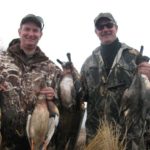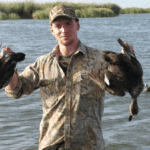
Duck hunting is all about getting out early and watching birds flying as the sunrises, right? Not if you’re hunting the Mississippi Delta.
The LSU-Ole Miss showdown wasn’t exactly a nail-biter. But our “tailgater” had Doc’s Venice houseboat fairly rocking and rolling with whoops and cheers as the Tigers put a 52-3 stomping on the Rebels.
And we weren’t the only ones celebrating. Half the houseboats around us also erupted in whoops and cheers. Complete bedlam reigned around us, and in short order many of these celebrants joined us for deer nachos, boiled crabs and grilled redfish — to say nothing of the keg Doc had so thoughtfully provided for the occasion.
The festivities continued until the inevitable lament went up.
“Don’t think I’m gonna make it in da morning,” Artie groaned. “Think I’m sleeping in, maybe fishing around mid-day.”
“Same here,” added Eddie.
“Who said anything about early morning duck-hunting?” Pelayo smirked.
“Shooot” Artie snorted. “My brud-n-law picks me up 3:30 when we hunt his lease at Cae-naaaw-von, which is 15 minutes from his house in Da Parish!”
“Been a while since you hunted the Delta, huh, Artie?” Pelayo laughed. “Heck, I’ll probably sleep in longer than you will tomorrow — and I’m STILL goin’ duck hunting.”
Next morning, we milled around the marina while fueling up, as several boats returned from the morning’s hunt.
“Not much flying this morning,” was a common complaint. “Ain’t barely had no waaaw-da to hunt in,” was another.
“Getting a late start, huh?” a mud-splattered hunter asked from the dock, as Pelayo cranked the engine.
“Actually, for us we’re getting a kinda early one,” Pelayo waved, as Eddie shrugged. “Heck, it’s only 10:30!”
“See that?” I pointed at a flag atop a big Hatteras. “That wind’s finally picking up.”
“And outta the southeast,” Pelayo said with a wide grin.
As luck would have it, in the Mississippi Delta the high tide always seems to come in the evening during the duck season. Many (but based on my observation, not most) duck hunters who hunt down here have adapted to these conditions and forsaken that dawn hunt (which means fighting the mudflats for a few shots at teal) for more sleep, some leisurely fishing and then some furious shooting as the tides rise and flood the duck potato and three-square mud flats, setting off the dinner (and flying) bell for the Delta’s swarms of puddle ducks.
As the water rises, the greys and pintails, along with swarms of teal usually take flight to feast, often with the sun directly overhead or maybe trending westward. Not what you’d call exactly traditional duck-hunting hours — for most, that is.
Oddly, we often have our best Delta duck hunts during the period from 10:30 a.m. to 3 p.m. or so. The high tides and high winds during this period have everything to do our peculiar timetable.
Strange but true.
This timetable also saves us a harrowing trip in the dark if the infamous Delta fog closes in as the sun goes down — as it usually does under the conditions that make for high tides in the Delta: southeast winds.
Much like deer, ducks have their feeding and resting (roosting) areas. Think about it. Rice-field hunting is typically early morning, crack-of-dawn stuff, the ducks buzzing all around even before legal shooting hours. Ditto for hunting in fresh marshes like Lake Salvador, LaBranche, upper Lafitte, Reggio and Ca-naaaw-von. These are all freshwater feeding areas.
Up in the Midwest, duck hunters know ducks feed in crop fields early morning and then fly into reservoirs, lakes and flooded timber later on to rest. Here’s where they ambush them.
We decided to stage our ambush by hanging a right about a mile down Dennis Pass in the Pass-A-Loutre WMA. We’d noticed rafts of pintails and greys in the area while on a preseason scouting/fishing trip.
With a different tidal timetable, the decision might have been different — we may have hunted closer to the marina in the Delta National Wildlife Refuge just north of this WMA. But for our type of duck hunting, tides play the crucial role in the Mississippi Delta.
“So much public land, so many ducks — so little time to scout!” is a constant lament down here.
Here’s the very tip of the Mississippi Flyway funnel, the continent’s main thoroughfare for migrating waterfowl. For millennia, the Mississippi and its tributaries have served as a network of highways for migrating ducks. Traditionally, almost a third of North America’s wildfowl wintered in South Louisiana, a good portion of them here.
This pattern has changed somewhat lately but not enough to discourage those who enjoy actually hunting ducks.
As mentioned, with an earlier high tide we might have hunted closer to the Delta National Wildlife Refuge — but the refuge only allows hunting until noon, which means today we would have found mainly mudflats and rafting, unbudgeable ducks during legal hunting hours.
Sadly this is all too often the case down here.
The natural spillways off Dennis (and Loomis, South, Southeast and Johnson passes) let the river water rush through every spring and build sandbars. By duck season, they’re sprouting duck potato, three-square grass and other tubers. The leaves and seeds are mostly gone by November, but those luscious (and nutritious) tubers remain just underground.
Best of all, that new sediment every year means sandy, semi-firm, walkable marsh in some choice areas. (You’ll often watch redfish fin through these firm, sandy shallows, so bring a pole in the pirogue and cash in on redfish during lulls in the shooting!)
“Tide’s already coming up,” I said, pointing at the little foam edge to the water half covering the mud/sand bank. “We’re in good shape.”
We’d just beached the boat when a jet-like roar passed over, and we jerked our heads up in time to see a band of green-winged teal almost decapitate us, then circle and plop into a cove about 200 yards ahead.
“You saw how fast they went down?” Pelayo croaked. “I bet that place is full of ducks. Look at all that duck potato.”
Almost on cue, mixed flocks of pintails and greys started peeling off from directly in front of us. Then a loose group of mallards and mottled ducks flapped off quacking from behind some bulrushes to our left.
We were seriously pumped.
“WOW!” was all Eddie could manage, as we started setting out the decoys while walking.
We’d just put out the 23rd decoy when Eddie yelped, “Look — in the decoys!”
Teal were landing in them even as we stood jamming palmetto leaves and bamboo into the mud around the ’rogue.
“SKIP the teal, man!” I gasped as we all started shucking in shells. “We’ll limit out in three minutes with them. Let’s wait for ….”
I stopped in mid sentence when I saw the colossal pintail drake eyeing the dekes cautiously from about 80 yards out. He flapped his wings and craned his neck cautiously. He was in the middle of his second circle around the decoys when I grabbed my whistle, and gave a shrill blast just as Pelayo opened up with a feeding chuckle.
It was magic.
The pintail cupped his wings, curved that long neck and started gliding in. No other duck can touch this guy. It was a spectacle of sheer elegance on the wing.
But he wasn’t coming in to land. At about 30 yards, he started gaining a little altitude and veering right.
Too late, buddy. Pelayo and Eddie rose, their guns boomed as one and the pintail crumpled, splashing down in a puff of feathers just outside the dekes.
Pelayo suddenly pointed left and ducked. A flock of six were winging in from 200 yards out.
We hunkered down in the ’rogue and watched them close the distance through the cracks in our bamboo and palmetto shroud. Their wings beat steadily. Their path was unwavering. None of that craning of the neck and looking around for company or a place to land.
They knew where they were going.
At my first hail, they slowed and banked. Eddie and Pelayo chimed in with more quacks and whistles, and they cupped.
We plastered our faces against the bamboo, and fingered the safeties. Uh-oh, at about 100 yards, the lead duck started veering. The others followed. They’d no longer be in range.
We mouthed the calls in desperation just as they swerved, and we saw the white of the underwings and bellies.
“Greys,” I snorted.
Pelayo let fly with a short, sharp hail (the way ducks, not mariachi trumpeters, do it) and the greys swerved back toward us. I chimed in, and they cupped. By the second circle, it looked like they’d consummate.
What a sight. These had their wings spread wide, exposing their white bellies as they hovered over the farthest decoys. Big beige feet started to dangle.
My heart was in my throat as we rose to greet them at point-blank range.
Blam!
Eddie beat me to the draw, and I saw one fold on the left.
BLAM! BLAM!
Pelayo and I shot almost as one, and two more cartwheeled into the dekes. I was drawing a bead on the last one but held off.
All three of these were down for good. The 6s had riddled them with fatal head and neck hits.
We stood there admiring the carnage.
Then another flock of four appeared from behind, heading straight for us. Again, we hunkered, turning our faces slightly to watch their approach.
These were spoonies, looking and acting like big blue-wings, as usual. They passed about 80 yards to the left, and I gave a short (three-note) hail.
One cupped immediately, and started banking. The others flew on. I called again and again. Pelayo added to the symphony of hailing and chuckling. After another hundred yards, the remaining trio decided to join the first.
But we hadn’t noticed a trio of greys that drifted in from our left!
What a picture. We had one spoonie circling behind us. He’d probably appear in range over the dekes in seconds — and we had three others gliding in from the front, still 150 yards out.
And we also had three big greys almost on the edge of the decoys!
Quite a dilemma.
“A bird in the hand,” they say. Hunkering down, we traded looks; we couldn’t even risk a whisper. Our eyes and grimaces said it all: “Do we blast this one that’s almost on top of us? Or wait for the trio?”
Then the first spoonie actually landed near the farthest deke, while the trio of greys glided in on cupped wings, meeting up with the approaching spoonies.
But these weren’t landing, just looking. They were well in range as we rose.
BLAM! BLAM! BLAM!
A grey and a spoonie folded. Another grey faltered but regained his altitude.
BLAM BLAM!
Now he crumpled.
Action was steady, and by 2:30 p.m. we had added several teal to the bag but were still four short of our three-man limit.
So we decided to head in. With this warm weather, the fog, no doubt, was on its way.
Besides, we’d already enjoyed a spectacular hunt — and in the most genuine sense of the word, as is typical for this area.






